Installing Geothermal Heating for Your Home: Is It Worth the Candle?
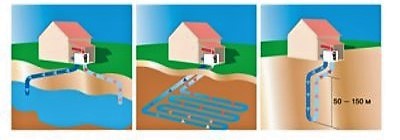
Geothermal heating is used for the heating system.
The main or additional source of heat production is earth energy.
Heating a house with heat from underground: what is it
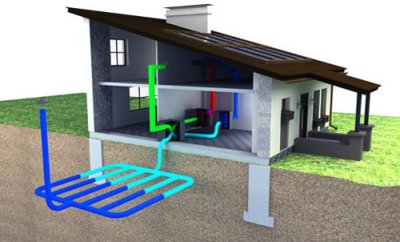
On the territory of Russia high-temperature (thermal) springs They are located extremely unevenly, mainly far from populated areas, which makes it difficult to use them for heating purposes.
As technology developed and new types of equipment were introduced, it became possible to use the technology to produce thermal energy. low temperature sources.
Among other things, underground layers located at a distance 50-100 meters below the earth's surface, have a positive temperature equal to 10—12 °C. These values are maintained regardless of time, which makes it possible to use heating throughout the year.
Advantages geothermal heating systems:
- Economy. The sources are renewable resources, which allows avoiding financial investments in the purchase of fuel, as in the case of using traditional systems. There will also be no additional costs associated with transportation and storage of fuel.
- Safety. It is unlikely that any emergency situations, explosions or fires will occur.
- Eco-friendlinessSince the combustion process is not used in a geothermal system, the emissions into the atmosphere that are inherent to it are eliminated.
- Autonomy. If there is automatic control, it does not require frequent intervention or constant external control.
Flaws:
- The initial costs are considerable monetary costs.
- Labor intensive installation.
- Necessity source of electrical energy.
How a Geothermal Heating System Works
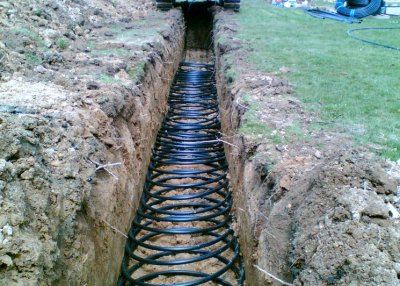
Heat for heating housing or supplying hot water is obtained by the method transformations it from the energy of the environment with the help of a special unit.
The main element of a geothermal plant is heat pump, which is connected to the internal and external heating circuit.
The structure of the internal circuit is similar to the traditional heating option (gas, water). This is: pipes and radiators.
Outer contour, the size of which is much larger than the internal one, being placed underground, is invisible during its operation. The coolant circulates inside it. This is: or ocommon water, or antifreeze, as a rule, - on the basis of ethylene glycol. And the second option is much preferable.
The temperature of the coolant is equalized with the temperature of the environment when it is in the external circuit, and then it is sent to the heat pump. After passing through it, the heated masses are directed along the inner contour.
The presence of a heat pump is the main factor for obtaining thermal energy, which is intended for subsequent use by the consumer (heating of housing, hot water supply).
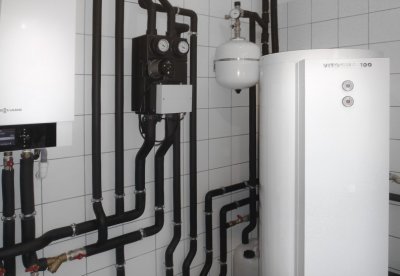
Efficiency This device may surprise some people. Consuming electrical energy in volume 1 kW as a result of his work "gives out" a little more - 4-5 kW, which looks very strange.
This is due to both the design features of the device and the fact that, in addition to electrical energy, it uses the thermal energy of the earth as an additional source (even at low soil temperatures).
The heat pump is capable of operating all year round and can be used for 15-25 years old.
Note! Some experts claim that taking into account friction or wear, real term of validity systems without stopping for repair work is about 10 years.
DIY installation
Before you decide to take such a step, you need to compare the possibilities with the volume and complexity of all the necessary work for installation of a geothermal system.
Cost calculation
The cost of installing a geothermal system is calculated relative to:
- acquisitions heat pump a certain power;
- prices of everything pipelines, in accordance with the pump power;
- production of related products earthworks (drilling wells, digging trenches), as well as the cost of work on laying networks;
- installations and connections heat pump.
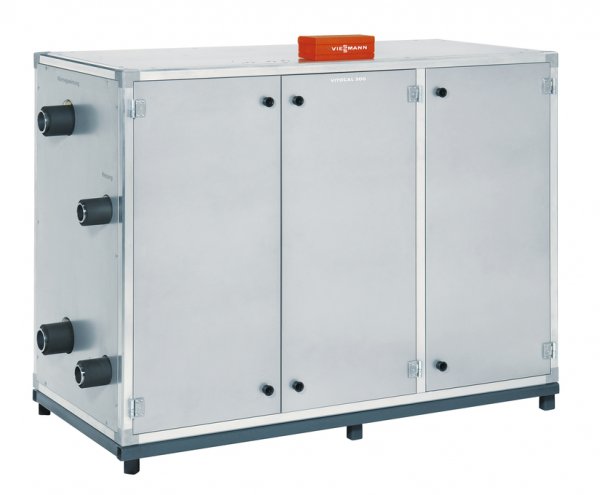
Photo 1. Geothermal heat pump model Vitocal 300-W Pro with electric drive for heating, manufacturer - "Viessmann".
The calculation also includes the purchase of a heat pump, the price of which varies depending on the capacity and manufacturer.
Models with power in the area 4-5 kW will be assessed in 3-7 thousand USD Device power 5-10 kW costs 4-8 thousand USD For 10-15 kW — 5-10 thousand USD
Collector placement
There is a division according to the method of installing the external contour (collector). IN soil it can be placed vertically or horizontally. In the ground reservoir — horizontallyEach of these cases has its own advantages and disadvantages.
Vertical type
When constructing a vertical type installation, there is a need for drilling wells 50-200 meters deep. That is, to the layer with the increased temperature. One of the shafts, which is called the debit shaft, serves to collect heat.

The coolant rises in it, thanks to the pump operation, then it is supplied to the pipes and radiators of the internal circuit.
Returning, after passing through the entire cycle, the coolant is discharged through another shaft back to the underground layers.
It is believed that the service life of such an installation is about hundreds of years.
When installing vertical type collectors with two shafts the efficiency of its use for heating a private house is reduced, since it will require a circulation pump to operate a significant amount of electricity. This is a suitable option for installing a "warm floor" system.
With more economical cluster method, the number of wells increases, but their depth decreases.
For vertical installation, there is also an option that involves strengthening the container (tank) containing antifreeze, at a depth of 100 mThe continuous movement of this liquid, heated by the ground, is provided by a heat pump.
If you do not consider the option of drilling wells for a vertical structure, which requires skills and equipment, then the work can be done independently.
Horizontal heat exchanger
A little effort will be required to install a horizontal heat exchanger (type), but the heat output in this case will be less. Excavation work will be required to construct pit below the freezing markThe external circuit pipeline is laid in the dug trenches, and subsequently the entire structure is covered with earth again.
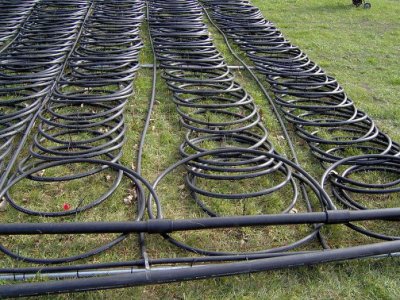
The temperature of the ground layer will be much lower and the length will be greater than when using a vertical type heat exchanger. Area approximately twice as muchthe room that needs to be heated.
The same principle is used to install a system in the underwater soil layer of a reservoir.
It is highly desirable that the area of the reservoir itself be more than 200 sq. m., and the distance from it to the heated building did not exceed 100 m.
At least required 1 m of water thickness from the freezing water surface. In addition, permission from special services is required if the body of water is not your property.
Attention! Some experts warn against doing all the work "with your own hands". According to them, such actions can turn out to be partial or complete damage to equipment.
Useful video
Check out this video for an overview of the installed geothermal heating system.
In conclusion
If we compare the cost of heating in its traditional options, then in terms of the long term, the installation of geothermal heating is a justified step, since there is hope that the costs will pay for itself within the first few years of operation systems.
Despite the difficulties, geothermal heating is becoming more popular in Russia. It remains to be hoped that domestic enterprises will begin to more actively master the production of heat pumps, so as not to overpay foreign manufacturers.






